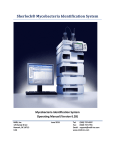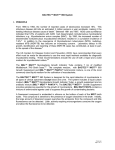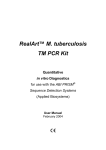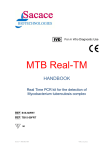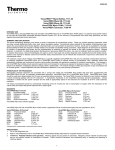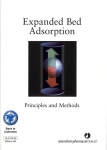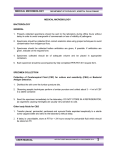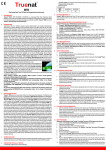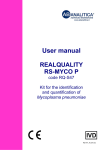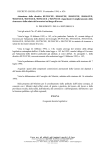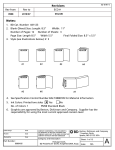Download AUTOMATED BLOOD CULTURE
Transcript
AUTOMATED BLOOD CULTURE BACTEC™ 9240/9120/9050 I. PRINCIPLE The detection of microorganisms in a patient’s blood has diagnostic and prognostic importance. Blood cultures are essential in the diagnosis and treatment of the etiologic agents of sepsis. Bacterial sepsis constitutes one of the most serious infectious diseases and, therefore, the expeditious detection and identification of bloodborne bacterial pathogens is an important function of the diagnostic microbiology laboratory. The BACTEC 9000 series of blood culture instruments are designed for the rapid detection of microorganisms in clinical specimens. The sample to be tested is inoculated into the vial which is entered into the BACTEC instrument for incubation and periodic reading. Each vial contains a sensor which responds to the concentration of CO2 produced by the metabolism of microorganisms or the consumption of oxygen needed for the growth of microorgnisms. The sensor is monitored by the instrument every ten minutes for an increase in its fluorescence, which is proportional to the increasing amount of CO2 or the decreasing amount of O2 present in the vial. A positive reading indicates the presumptive presence of viable microorganisms in the vial. II. MATERIAL A. MEDIA 1 1. BACTEC PLUS Aerobic/F Culture Vial Optimum blood volume for each vial is 8 to 10 mL; 3 to 10 mL of blood is acceptable. a. Each vial contains: • • • • • • 25 mL Enriched Soybean-Casein Digest broth (TSB) 0.05% Sodium Polyanetholesulfonate (SPS) Cationic and Non-ionic Adsorbing Resins Carbon dioxide (CO2) Oxygen (O2) Sensor for the detection of fluorescence b. Store at 2° to 25° C 9000 bc2 RevisionB 7/25/01 Page 1 of 21 1 2. BACTEC™ PLUS Anaerobic/F Culture Vial Optimum blood volume for each vial is 8 to 10 mL; 3 to 10 mL of blood is acceptable. a. Each vial contains: • • • • • 25 mL pre-reduced enriched Soybean-Casein Digest broth. 0.05% SPS Resins CO2 and Nitrogen gas (N2) Sensor for the detection of fluorescence. b. Store at 2° to 25° C. 2 3. BACTEC PEDS PLUS/F Culture Vial Optimum blood volume for each vial is 1 to 3 mL; 0.5 to 5 mL of blood is acceptable. a. Each vial contains: • • • • • • 40 mL Enriched Soybean-Casein Digest broth 0.02% SPS Resins CO2 O2 Sensor for the detection of fluorescence. b. Store at 2° to 25° C. 9000 bc2 RevisionB 7/25/01 Page 2 of 21 MEDIA (CONT.) 4. BACTEC MYCO/F LYTIC3 A non-selective culture medium for the recovery of yeast and fungi from blood and body fluids and mycobacteria from blood specimens. The optimum specimen volume is 3 to 5 mL; 1 mL to 5 mL is acceptable. a. Each vial contains: • • • • • • • • • • • • • • • • 40 mL Processed Water Middlebrook 7H9 Broth Base Brain Heart Infusion Casein Hydrolysate Supplement H Inositol Glycerol SPS Tween 80 Pyridoxal HCl Ferric Ammonium Citrate Potassium Phosphate Saponin Antifoam CO2 and O2 Sensor for the detection of fluorescence. B. MATERIALS REQUIRED BUT NOT PROVIDED VACUTAINER™ SAFETY-LOK™ Blood Collection Set OR 20 mL LUERLOK™ syringe with a 21 gauge needle, 3 mL LUER-LOK syringe with a 23 gauge needle, PERSIST™ Povidone Iodine Prep, 70% isopropyl alcohol (alcohol pads); Biological Safety Cabinet, autoclave; venting units, mycobactericidal disinfectant; microscope, materials for staining slides and subculturing supplies. C. INSTRUMENT 1. BACTEC™ 9240/9120/9050 (BACTEC Fluorescent Series) Microorganisms, if present in the blood samples, metabolize nutrients in the BACTEC culture vial and release CO2 into the medium or utilize the oxygen in the medium. The instrument monitors the fluorescence of the vial sensor which increases as CO2 is produced or oxygen is utilized. Analysis of the rate and amount of CO2 produced or O2 utilized enables the instrument to determine if the vial is positive; i.e., the presumptive presence of viable organisms. 9000 bc2 RevisionB 7/25/01 Page 3 of 21 2. Computer and peripherals The system computer stores all the system software, including the application software which controls instrument operations and the user interface, which enables the user to enter patient information, view results, print reports, identify errors, etc. NOTE: The microprocessor associated with each rack is responsible for the actual testing of the vials and positivity analysis. 3. Barcode Scanner The barcode scanner is located on the inside of the instrument to provide the ability to activate barcode commands and to scan vial labels for specimen identification. When the door is opened and an activity is initiated, the scanner is activated and is ready to read the vial barcode.4 The barcode scanner for the BACTEC 9050 is located on the front of the instrument and is activated when the door is opened and the vial entry or vial removal soft keys are pushed.5 III. SPECIMEN A. COLLECTION 1. SITE SELECTION a. Select a different body site for each culture drawn. b. Avoid drawing blood through indwelling intravascular catheters unless blood can not be obtained by venipuncture. Blood collected from intravascular catheters should be done with the knowledge that contamination may be an issue. 2. SITE PREPARATION (PERSIST Povidone Iodine Prep) a. Open the PERSIST package by tearing completely through at the side notches and twisting. b. Leave the package over the end of the swabstick to prevent gloves from becoming covered with solution. c. Apply PERSIST by beginning at the intended venipuncture site, working in a circular motion with friction, covering an area of 2-3 inches in diameter. Do not return to the center of the site once swab has moved outward to the periphery. Persist™ should be applied with friction and the site prepped 30 seconds to 1 minute. d. Allow PERSIST solution to air dry. e. DO NOT touch or palpate the area after cleansing. 3. DISINFECTING BLOOD CULTURE VIALS9000 bc2 RevisionB 7/25/01 Page 4 of 21 a. Remove the flip-off caps from BACTEC culture vials. b. Wipe top of each vial with a separate 70% isopropyl alcohol pad and allow to dry. c. Do not use iodine to disinfect tops of vials. 4. VENIPUNCTURE a. Avoid touching the venipuncture site. If it is necessary to touch the site after it has been cleaned, wipe your fingers with povidone iodine before touching the site. b. When using the Blood Collection Set (“butterfly”) the phlebotomist MUST carefully monitor the volume collected by using the 5 mL graduation marks on the vial label. If the volume is not monitored, the stated maximum amount collected may be exceeded. This condition may adversely create a ‘false’ positive result, due to high blood background. c. If using a needle and syringe, typically a 20 mL syringe is used for adults. Draw 16 to 20 mL of blood for one blood culture set (aerobic and anaerobic). Aseptically inject 8 to 10 mL of specimen into each vial. Aseptically inject 3 to 5 mL into the MYCO/F LYTIC vial. d. For pediatric patients, a 3 mL syringe is frequently used. Draw 1 to 3 mL of blood and transfer the entire amount into BACTEC™ PEDS PLUS/F vial. e. After all specimens have been collected from the individual, use a sterile alcohol pad to remove the povidone-iodine solution from the venipuncture site. f. Continue to care for the venipuncture site following guidelines recommended by your institution. g. The inoculated BACTEC vials should be transported as quickly as possible to the laboratory. 9000 bc2 RevisionB 7/25/01 Page 5 of 21 B. VOLUME The volume of blood cultured is critical because the number of organisms per mL of blood in most cases of bacteremia is low, especially if the patient is on antimicrobial therapy. In infants and children, the number of organisms per mL of blood during 6 bacteremia is higher than adults, so less blood is required for culture. 1. Children: 1 to 5 mL of blood per venipuncture. Transfer the entire amount to a BACTEC™ PEDS PLUS/F vial. 2. Adult: 16 to 20 mL of blood per venipuncture. If it is impossible to draw the required amount, aliquot as follows: Amount per Venipuncture 16-20 mL Amount in BACTEC Plus Aerobic Vial Amount in BACTEC Plus Anaerobic Vial Split equally between aerobic and anaerobic vials 13-16 mL 8 mL 5 - 8 mL 10-12 mL 5 - 7 mL 5 mL 5-9 mL entire blood amount 0 NOTE: Optimum recovery of isolates will be achieved by adding 8 to 10 mL of blood (BACTEC PEDS PLUS/F: 1 - 3 mL; BACTEC MYCO/F LYTIC - 3 to 5 mL). The use of lower or higher volumes may adversely affect recovery and/or detection times. C. SPECIMEN LABELING 1. Each vial should be labeled with the appropriate patient information: • • • • • • • Patient’s name Hospital number (Patient ID) Patient’s location (room and bed #) Date and time of collection Collector’s initials Site of venipuncture Or other information as per facility 2. Each request slip should also have all the information above. 9000 bc2 RevisionB 7/25/01 Page 6 of 21 D. NUMBER AND TIMING Most cases of bacteremia are detected using two to three sets of separately collected blood cultures. More than three sets of blood cultures yield little additional information. Conversely, a single blood culture may miss intermittently occurring bacteremia and make it difficult to interpret the clinical significance of 6 certain isolated organisms. IV. QUALITY CONTROL A. MEDIA Each case of media has a Quality Control certificate indicating the organisms tested and the acceptibility of those tests. The laboratory may wish to test each shipment of media for performance through the use of a positive and negative vial test. The positive vial should be inoculated with 1.0 mL of a 0.5 McFarland Standard of either Escherichia coli or Staphylococcus aureus prepared from a fresh 18 - 24 h culture. This vial and an uninoculated vial should be logged into the instrument and tested. The inoculated vial should be detected as positive by the instrument within 72 hours. The negative control vials should remain negative throughout the entire testing protocol. This verifies that the media were not subject to adverse storage or shipping conditions prior to receipt in the laboratory. If either of these vials do not give the expected results, do not use the media until you have contacted Technical Services, BD Biosciences at 1-800-638-8663, prompt 2.(U S only) It is recommended that each new shipment or lot of BACTEC MYCO/F LYTIC media be tested with the ATCC control organisms identified in the chart below as positive control, and an uninoculated vial as a negative control. Organism Mycobacterium intracellulare ATCC™ 13950 Candida glabrata ATCC 15545 Cryptococcus neoformans ATCC 13690 Range of Time-to-detection (days) 8 to 16 <3 <3 The positive control vials should be inoculated using a 1:100 dilution of a McFarland #1 suspension of microorganisms grown on solid medium. Inoculate the vial with 0.1 mL of the diluted culture. The positive control vials and an uninoculated control vial should be scanned into the instrument and tested. The inoculated vial should be detected as positive by the instrument within the test protocol i.e. range of time to detection as stated above. The negative control should remain negative. If expected results for Quality Control are not obtained, do not use the medium and contact BD Biosciences Technical Services (in the US only: 1-800-638-8663) or your local BD Biosciences Representative for further assistance. 9000 bc2 RevisionB 7/25/01 Page 7 of 21 B. INSTRUMENT MAINTENANCE 1.0 BACTEC 9240/9120: The following procedures should be performed at the start of each day’s testing and recorded on the maintenance log. 1.1 Check temperature readout of each rack and cabinet on the instrument’s temperature controller. Verify that the temperature of o o o each rack is 35 C ± 1.5 C and the cabinet temperature is 30 C ± o 1.0 C. Also, verify that the temperature of the calibrated internal o o temperature probe is 35 C ± 1.5 C. If any rack or cabinet is not within the specified temperature range, call BD Biosciences Field Service at 1-800-544-7434. 1.2 Check rack indicator operation by opening the instrument door and using the barcode scanner. a. Scan the selection, ILLUMINATE GREEN RACK INDICATORS. Listen for a beep indicating the scan is successful. The GREEN lamps at each station should illuminate. If any lamp does not, the station should be removed from service. Refer to User’s Manual (Section 4.3) for how to remove a station from service. b. Scan the selection, ILLUMINATE RED RACK INDICATORS. Listen for a beep indicating the scan is successful. The RED lamps at each station should illuminate. If any lamp does not, the station should be removed from service. Refer to User’s Manual (Section 4.3) for how to remove a station from service. c. Scan the selection, ILLUMINATE FRONT PANEL INDICATORS. All four of the indicator lamps on the front of the instrument should illuminate together then one at a time. If any lamp does not, refer to User’s Manual (Section 6.7) for instructions on replacing the burned out lamp. d. Scan the selection, AUDIBLE ALARM TEST. The instrument’s audible alarm will sound three times. The pattern “BD” is also displayed in the station LED’s (light emitting diodes) followed by the instrument number (BACTEC™ 9240 only). If the alarm doesn’t sound, contact BD Biosciences Field Service at 1-800544-7434. 9000 bc2 RevisionB 7/25/01 Page 8 of 21 INSTRUMENT MAINTENANCE (CONT.) 1.3 Perform system backup a. Use a 3½ inch, high density, formatted and not write-protected, diskette. b. From the main menu, press [F5] or Utilities menu. c. From the Utilities menu, press [F5] or Backup. d. Insert the diskette in the disk drive. e. Press [F10] to begin the backup process. f. When the backup is completed, remove the diskette and store it in a safe place. g. Use a different diskette every day. (Maintain a set of seven diskettes with each diskette labeled with a different day of the week.) 1.4 Weekly, check the air filter at the rear of the instrument. Clean and replace the filter monthly. Refer to the User’s Manual (Section 6.6). 2.0 BACTEC 9050: The following checks should be performed daily: 2.1 Check the temperature readout on the LCD display on the instrument. Verify that the temperature of the instrument and internal temperature o o vial read 35 C ± 1.5 C. 2.2 If a printer is attached to the instrument, check the paper supply. 2.3 Change or clean the air filters on both sides of the instrument monthly. Check the filters more frequently if the laboratory's environment is dusty. Refer to the User's Manual (Section 6.2). V. PROCEDURE 9000 bc2 RevisionB 7/25/01 Page 9 of 21 A. GENERAL SAFETY CONSIDERATIONS Pathogenic microorganisms, including Hepatitis B Virus and Human Immunodeficiency Virus, may be present in specimens. “Universal 9,10 and institutional guidelines should be followed in handling all Precautions” items contaminated with blood or other body fluids. 1. Wear gloves while handling inoculated vials. 2. Perform all blood culture processing in a biological safety cabinet. 3. Properly dispose of all contaminated materials. Place syringes, needles, and other sharp contaminated materials in a puncture proof container. WARNING: Never attempt to recap a needle. B. PROCESSING NEW BLOOD CULTURES 1. ENTERING DATA AND LOADING INSTRUMENT 1.1 BACTEC 9240/9120 a. Entering Data into the Computer: • From the Main menu, press [F3] Culture • Complete the following fields: 9 9 9 9 9 9 Patient’s ID Patient’s Name Accession Number Collection Date Collection Time Hospital Service • Advance the cursor to the sequence number field. With the computer’s barcode scanner, scan the vial barcode label. The sequence number, media type, station number, and the status field are then filled in automatically. • Check the protocol field. (Default protocol is 5 days for blood cultures and 42 days for MYCO/F LYTIC). NOTE: To change the length of the testing protocol, use the [↓] to advance the cursor to the protocol field and enter the desired value (1 to 42 days). ENTERING DATA AND LOADING INSTRUMENT (CONT) • Press [F10] to save the entry. • Enter a different Accession number for each culture. 9000 bc2 RevisionB 7/25/01 Page 10 of 21 b. Loading the Instrument: • Take the new vials to the instrument and open the instrument doors. • Scan the vial’s barcode label. Listen for the beep indicating a successful scan and look for the station with the illuminated GREEN and RED LED. • Insert the vial into that station. • Repeat the above step for each of the new vials. NOTE: If you haven’t already entered the patient’s data into the computer, be sure to write down the station number on the patient’s requisition slip to use for logging patient’s information into the computer at a later time. • Close the instruments doors. NOTE: Avoid placing vials into the instrument without scanning the barcode. If vials are not scanned into the instrument, they will become ANONYMOUS VIALS. An anonymous vial must be identified as soon as possible so that the instrument can display the vial’s current status (i.e., ongoing, positive, etc.) Identifying an anonymous vial involves the removal and re-insertion of vials, which can result in an increase of false positive rates. Refer to User’s Manual (Section 4.9) for identifying anonymous vials. c. Replacing Vial Barcode Labels NOTE: Extra vial sequence barcode labels are included in the instrument start-up kit. These labels can be used to replace damaged or unreadable labels on culture vials. The barcode labels contain sequence numbers which uniquely identify each vial. • Ensure that the area where the defective label is located is clean and dry. If the old label is wrinkled or creased, peel off as much as possible to make a smooth surface on which to apply the new label. • Peel off the new barcode label. Verify that the new label is printed clearly and that no smears, smudges, or other markings obstruct the lines of the barcode. • Align the new label with the old label, and press the new label into place, being careful not to create any bubbles or ridges in the barcode area. NOTE: If you replace a barcode label the system requires you to scan a media barcode (located on the media barcode placard) immediately after scanning the replacement vial sequence barcode. It is very important that you scan the correct barcode 9000 bc2 RevisionB 7/25/01 Page 11 of 21 for the type of media, since the system applies different positivity criteria to the different types of media. 1.2 BACTEC 9050: Press the Home Rotor soft key for easier loading. This will position the rotor at the "HOME" position with the temperature standards in the 12:00 position. a. Entering New Vials: • Take the new vials to the instrument and open the door of the instrument. • Press the VIAL ENTRY soft key. • Scan the vial barcode by placing the vial in the alignment block in front of the scanner with the barcode facing the scanner. If necessary, rotate the vial slightly so the scanner will read the label. The system beeps once to indicate a successful scan. NOTE: If the vial barcode is covered or damaged, press the NO BARCODE soft key. Select the vial media by using the [↑] or [↓] keys. Press the OK soft key to confirm the media type. • Insert the vial into the position indicated on the LCD display. • If the default protocol is acceptable, press the OK soft key. NOTE: To modify the protocol length for a particular vial, select the CHANGE PROTOCOL soft key. Use the [↑] or [↓] keys to select the desired protocol length. • Verify that all of the information displayed is correct and that the vial has been inserted into the indicated station. Press the OK soft key to confirm. • Repeat the above step for each new vial. Press the EXIT soft key when all of the new vials have been entered. BACTEC 9050 VIAL ENTRY (CONT.) • Close the door of the instrument. NOTE: Avoid placing vials into the instrument without scanning the barcode. If vials are placed into the instrument without scanning, they will become ANONYMOUS VIALS. An anonymous vial must be identified as soon as possible so that the instrument can display the vial's current status (i.e., Ongoing, Positive, etc.). Identifying an anonymous vial involves the removal and re9000 bc2 RevisionB 7/25/01 Page 12 of 21 insertion of vials, which can result in an increase of false positive rates. Refer to the User's Manual (Section 4.2) for instructions . d. Replacing Vial Barcode Labels NOTE: Extra vial sequence barcode labels are included in the instrument start-up kit. These labels can be used to replace damaged or unreadable labels on culture vials. The barcode labels contain sequence numbers which uniquely identify each vial. • Ensure that the area where the defective label is located is clean and dry. If the old label is wrinkled or creased, peel off as much as possible to make a smooth surface on which to apply the new label. • Peel off the new barcode label. Verify that the new label is printed clearly and that no smears, smudges, or other markings obstruct the lines of the barcode. • Align the new label with the old label, and press the new label into place, being careful not to create any bubbles or ridges in the barcode area. • The vial can now be entered into the instrument through vial entry. 2. POSITIVE CULTURES 2.1 BACTEC 9240/9120: The system will notify the presence of presumptive positive vials in several ways: • An audible alarm sounds (if configured) and the computer Title and Cabinet windows flash. • The Positive Indicator Lamp on the front of the instrument iluminates (yellow). POSITIVE CULTURES (CONT.) • On the computer’s instrument status display, the station number and the total positives in the summary window are displayed in FLASHING GREEN, FLASHING RED. a. To Remove the Positive Vials: • Press [F2] to acknowledge the alarm. • Open the instrument doors, and using the instrument barcode scanner scan the menu option REMOVE POSITIVES. Listen for a beep indicating that the item was scanned successfully. 9000 bc2 RevisionB 7/25/01 Page 13 of 21 • Find the station with the FLASHING GREEN and RED LEDs. Remove the vial and scan its barcode using the instrument barcode scanner. Listen for the beep and the LEDs will extinguish. • If the instrument is configured to show related vials, the vial with the same patient ID and Accession number will be indicated by a solid GREEN LED. If you wish to remove this vial for subculture, scan its label with the instrument barcode scanner after you remove the vial from its station. NOTE: Related vials should be replaced within 10 minutes. • Repeat the appropriate steps above for each additional positive. The acknowledged alarm condition is not clear until all the positive vials are removed. NOTE: A Gram stain and a subculture should be performed from each presumptive positive vial. b. To Return ‘Smear Negative’ Positive Vials and Related Vials: • To return the removed related vial to the instrument, open the doors and scan the vial’s barcode using the instrument barcode scanner. The original station will be indicated by solid GREEN and RED LEDs. Return the vial to this station. The data from the related vial are maintained until explicitly removed as a positive or a final negative. • To return a ‘smear negative’ positive vial to the instrument, open the doors and scan the vial’s barcode using the instrument barcode scanner. The original station will be indicated by FLASHING GREEN and RED LEDs changing to solid GREEN and RED LEDs. NOTE: Original station location will be ‘held’ for three hours after a positive vial has been removed from the instrument. The data for the returned positive vial are maintained until explicitly removed as a positive or a final negative. 2.2 BACTEC 9050: a. The system notifies the user of the presence of presumptive positive vials in several ways: • An audible alarm sounds if the instrument is configured to a volume of >0. • The NEW POSITIVE INDICATOR on the front of the instruments flashes RED. 9000 bc2 RevisionB 7/25/01 Page 14 of 21 • The REMOVE POSITIVES soft key appears in the LCD display when the instrument door is opened. • On the Main Status display, the station with the positive vial is displayed as a filled circle with a plus sign (+) in it, and the positive total in the Summary region reflects the number of positives in the instrument. b. To Remove the Positive Vials: • Press the SILENCE ALARM key to acknowledge the alarm. (Available only if instrument has been configured to a volume of >0.) • Open the door of the instrument and press the REMOVE POSITIVES soft key. • LCD display indicates the positive vial by position and the barcode number of the vial. • Remove the vial from the indicated station and scan the barcode label on the vial. • Repeat the appropriate steps until all of the positives are removed. Three audible beeps indicate all positive vials have been removed. • Press the EXIT soft key. • Close the door of the instrument. 9000 bc2 RevisionB 7/25/01 Page 15 of 21 NOTE: If the positive vial was originally entered manually (by selecting media type), the LCD displays the station location only. Remove the vial from the specified station and press the FORCE STATION AVAILABLE soft key. NOTE: A subculture and a Gram stain should be performed from each presumptive positive vial. c. To Return "Smear Negative" Positive Vials to the BACTEC 9050: • Open the door of the instrument and press the VIAL ENTRY soft key. • Scan the vial barcode and place the vial in the indicated station shown on the LCD display. This station may differ from the original station. NOTE: If the vial was originally entered by scanning the barcode label, the system reserves the station for re-entery of the pulled positive vial for up to 3 hours. The re-entry feature resets positivity routines, retains the previous test readings, and continues to test the vial as an ongoing culture. If the vial was originally entered manually, the system treats the re-entered vial as a new vial. 3. NEGATIVE CULTURES a. Negative cultures may exist as ongoing negatives (in protocol) and out-of-protocol negatives. b. The BACTEC 9240/9120 instrument systems will indicate ongoing negatives by displaying the station number as solid green digits on the computer’s instrument status screen. Ongoing negatives are displayed as a solid circle on the Main Status Display of the BACTEC 9050. c. Out-of-protocol negatives will be displayed in flashing green digits on the BACTEC 9240/9120 computer’s instrument status display. Also, the negative count in the summary window of the computer will flash green. Out-of-protocol negatives in the BACTEC 9050 are displayed as a solid circle with a minus sign (-) in the Main Status Display. The summary region reflects the number of negatives in the instrument. Also, the REMOVE NEGATIVES soft key appears when the door is opened. 9000 bc2 RevisionB 7/25/01 Page 16 of 21 d. To Remove Out-of-Protocol Negatives from the BACTEC 9240/9120 instrument systems: • Open the instrument doors. • Scan the menu option, REMOVE NEGATIVES using the instrument barcode scanner. Listen for a beep from the scanner indicating the item was scanned successfully. • Find the station(s) with FLASHING GREEN LEDs and remove the vial. • Scan the vial barcode label using the instrument barcode scanner. Listen for the beep indicating a successful scan and the GREEN LEDs will extinguish. • Repeat the above two steps to remove additional negatives. e. To Remove Out-of-Protocol Negatives from the BACTEC 9050: • Open the door to the instrument. • Press the REMOVE NEGATIVES soft key. The LCD display indicates the position and the barcode number of the negative vials. • Remove the vial from the station and scan the barcode label. NOTE: If the vial was originally entered by selecting the media type, the LCD displays the station location only. Remove the vial from the specified station and press the FORCE STATION AVAILABLE soft key. • Repeat the appropriate steps until all negatives are removed. Three audible beeps sound when the removal process is completed. • Press the EXIT soft key. • Close the door of the instrument. 9000 bc2 RevisionB 7/25/01 Page 17 of 21 4. PROCESSING AN INSTRUMENT - POSITIVE VIAL a. Remove the vial from the instrument and place in a biological safety cabinet. b. Invert the vial to mix the contents. c. Observe “Universal Safety Precautions”10, 11 to vent each presumptive positive blood culture vial. Use a venting needle (BBL™ Venting Units catalog # 271056). d. Remove aliquot from the vial for stain preparations (Gram and/or AFB). e. Subculture vials according to the Gram stain and/or AFB stain results. f. Report preliminary results only after stain preparation. g. Perform identification and susceptibility of organism(s) grown on solid media according to your laboratory protocol. VI. LIMITATIONS Contamination Care must be taken to prevent contamination of the sample during collection and inoculation into the BACTEC™ vials. A contaminated sample will give a positive reading, but this does not indicate a clinically significant result. Such a determination must be made by the user, based on such factors as type of organisms recovered, occurrence of the same organism in multiple cultures, patient history, etc. Recovery of SPS Sensitive and Fastidious Organisms from Blood Samples Because blood can neutralize the toxicity of SPS toward organisms sensitive to SPS (such as some Neisseria species), the presence of optimum volumes of blood, based on media type, benefits the recovery of these organisms. To enhance the growth of SPS sensitive organisms when less than optimum volumes of blood are inoculated, additional whole human blood may be added. Some fastidious organisms, such as certain Haemophilus species, require growth factors, such as NAD, or factor V, which are provided by the blood specimen. If the blood specimen volume is 3.0 mL or less for BACTEC™ PLUS Aerobic/F and Anaerobic/F or 0.5 mL or less for BACTEC™ PEDS PLUS/F, an appropriate supplement may be required for recovery of these organisms. BACTEC BRAND FOS™ Fastidious Organism Supplement (catalog # 442153) or whole human blood may be used as nutritional supplements. 9000 bc2 RevisionB 7/25/01 Page 18 of 21 Non-viable Organisms A Gram-stained smear from a culture medium may contain small numbers of nonviable organisms derived from medium constituents, staining reagents, immersion oil, glass slides, and specimens used for inoculation. In addition, the patient specimen may contain organisms that will not grow in the culture medium or on media used for subculture. Such specimens should be subcultured to special media 6, 7 as appropriate. Antimicrobial Activity Neutralization of the antimicrobial activity by resins varies depending on dosage level and timing of specimen collection. Studies have demonstrated that the resins present in this medium do not adequately neutralize imipenem-cilastatin antimicrobial preparations. Recovery of Streptococcus pneumoniae In aerobic media, S. pneumoniae will typically be visually and instrument positive, but in some cases no organisms will be seen on Gram stain or recovered on routine subculture. If an anaerobic vial was also inoculated, the organism can usually be recovered by performing an aerobic subculture of the anaerobic vial, since this 8 organism has been reported to grow well under anaerobic conditions. General Considerations Optimum recovery of isolates will be achieved by adding the appropriate volume of blood for the type of vial inoculated. Use of lower or higher volumes may adversely affect recovery and/or detection times. Blood may contain antimicrobials or other inhibitors which may slow or prevent the growth of microorganisms. False negative readings may result when certain organisms do not produce enough CO2 to be detected by the system or if significant growth has occurred before placing the vial into the system. False positivity may occur when the white blood cell count is high. It is recommended that related vials remain out of the instrument for no more than 10 minutes to minimize the possibility of the vial becoming a “false” positive vial. BACTEC MYCO/F LYTIC vials are not selective and will support the growth of other aerobic organisms besides mycobacteria, yeast and fungi. Positive vials may contain one or more species of mycobacteria and/or other non-mycobacterial species. If present, fast growing organisms may mask the detection of slower growing mycobacteria, yeast and fungi. Subculture and additional procedures are required. The consistency of microscopic morphology in BACTEC MYCO/F LYTIC has not been established. Inoculation of blood volumes of 1 to 5 mL are acceptable; but optimum recovery is obtained with 3 to 5 mL. During internal studies with less than 3 mL of blood, M. intracellulare, M. malmoense, M. haemophilum and M. xenopi exhibited detection delays and/or compromised recovery with BACTEC MYCO/F LYTIC. False positivity most likely will increase when the blood volume is above 5 mL. Mycobacteria may vary in acid-fastness depending on strain, age of culture and other variables. 9000 bc2 RevisionB 7/25/01 Page 19 of 21 Blood may contain antimicrobials or other inhibitors which may slow or prevent the growth of microorganisms. BACTEC MYCO/F LYTIC vials are incubated at 35°C potentially precluding the recovery of mycobacteria requiring other incubation temperatures such as M. marinum, M. ulcerans, or M. haemophilum. Recovery of such organisms requires additional culture methods. Penicillium purpurescens and Blastomyces dermatitidis were not detectable in the BACTEC MYCO/F LYTIC culture medium. Hansenula anomala, Exophila jeamselmei, Actinomyces bovis, Rhodotorula rubra and Mucor ramosissimus exhibited inconsistent results at low inoculum levels (<10 CFU/vial) with seeded culture studies. Recovery of such organisms may require additional culture methods. The following isolates were detected as positive is the BACTEC MYCO/F LYTIC medium during internal seeded studies and/or clinical trials: Mycobacterium terrae Mycobacterium tuberculosis Mycobacterium avium Mycobacterium kansasii Mycobacterium fortuitum Mycobacterium intracellulare Mycobacterium gordonae Mycobacterium szulgai Mycobacterium simiae Mycobacterim celatum Mycobacterium abscessus Mycobacterium xenopi Mycobacterium malmoense Mycobacterium haemophilum Candida albicans Candida glabrata Candida parapsilosis Candida krusei Candida tropicalis Ajellomyces dermatitidis Cryptococcus neoformans Histoplasma capsulatum Aspergillus flavus Aspergillus fumigatus Nocardia asteroides Malasezzia furfur Trichophyton rubrum Any vial assigned to a new station (i.e., in the event of a bad station) should be subcultured immediately prior to placing in the new station. VII. REFERENCES 1. BACTEC™ PLUS Aerobic/F and PLUS Anaerobic/F Culture Vials Insert. Rev. PP-088E BD Biosciences. 2. BACTEC™ PEDS PLUS/F Culture Vials Insert.Rev. PP-091-I. BD Biosciences. 3. BACTEC MYCO/F LYTIC Culture Vials Insert.Rev. PP-162C. BD Biosciences. 4. BACTEC Fluorescent Series Users Manual. Document Number MA - 0074. BD Biosciences. 5. BACTEC 9050 System User’s Manual. Biosciences. Document Number MA-0103. BD 6. BACTEC Blood Culture Procedural Trays. Document Number L-001810 (A). BD Biosciences. 7. Isenberg, H.D. editor in chief. 1992. Clinical Microbiology Procedures Handbook. American Society for Microbiology, Washington, DC. 8. Balows, A. et al. Manual of Clinical Microbiology. 6th ed. American Society for Microbiology, Washington, DC, 1995. 9000 bc2 RevisionB 7/25/01 Page 20 of 21 9. Howden, R.J. J. Clin. Path. 1976, 29:50-53. 10. Recommendations for preventing transmission of Human Immunodeficiency Virus and Hepatitis B Virus to patients during exposure-prone invasive procedures. MMWR 1991, Vol. 40, No. RR-8. 11. Bloodborne Pathogens. Code of Federal Regulations, Title 29, Part 1910.1030 Federal Register 1991, 56:64175-64182. 12. Reller, L. B., P. R. Murray, and J. D. McLowry. 1982. Cumitech 1A, Blood Culture III. Coordinating ed., J. A. Washington II. American Society for Microbiology, Washington, DC. BACTEC, BBL, FOS, LUER-LOK, SAFETY-LOK, PEDS PLUS/F, PERSIST and VACUTAINER are trademarks of Becton Dickinson and Company. ATCC is a trademark of the American Type Culture Collection TECHNICAL SUPPORT: For information or assistance, call toll free 1-800-6388663, selection 2. Approved By: ____________________ Date Effective: ___________________ Supervisor:_______________________ Date:_________________ Director:_________________________ Date:__________________ 9000 bc2 RevisionB 7/25/01 Page 21 of 21





















